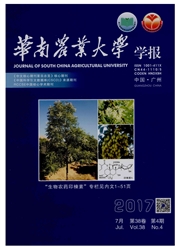

 中文摘要:
中文摘要:
亚洲栽培稻Oryza sativa与短花药野生稻O.brachyantha分别属于稻属的AA和FF染色体组,其种间杂交障碍影响了短花药野生稻有利基因向栽培稻的转移利用.本研究利用激光扫描共聚焦显微术对栽培稻与短花药野生稻杂交后杂种胚胎和胚乳发育以及杂种胚囊发育过程进行了观察.结果表明,杂交小穗双受精率高达82.93%,但是杂种胚胎发育到球形胚期停滞并开始解体,游离胚乳核未能正常细胞化而出现解体,导致杂种胚胎在发育中途夭亡,不能形成正常成熟的杂种种子.杂种胚囊发育过程中,大孢子母细胞可进行减数分裂,但形成四分体异常,导致功能大孢子异常,胚囊发育到单核或二核即出现退化现象,最终无法形成正常成熟的胚囊,表现高度的雌性不育.
 英文摘要:
英文摘要:
Oryza sativa and O.brachyantha belong to AA and FF genomes in genus Oryza,respectively.The interspecific hybridization barrier limits the transfer of elite genes from O.brachyantha into O.sativa.By using technique of whole-mount eosin B-staining confocal laser scanning microscopy,the development of hybrid embryo and endosperm after crossing between O.sativa and O.brachyantha and embryo sac abortion process of interspecific hybrid F1 were observed.The results showed that there was a high double-fertilization ratio of 82.93% appearing in the pollinated spikelets,but hybrid embryo ceased to develop and began to degenerate at the globular-shaped stage,meanwhile,free endosperm nuclei degenerated before forming cellular endosperm.It induced hybrid embryo abortion and the matured hybrid seed failed be produced.During the process of hybrid embryo sac development,hybrid megasporocyte finished meioses,but abnormal tetrad was formed which induced abnormal functional megaspores.Embryo sac was degenerated at the stage of mono-nucleate and two-nucleate embryo sac,therefore,no normal embryo sac was formed and hybrid was highly sterile.
 同期刊论文项目
同期刊论文项目
 同项目期刊论文
同项目期刊论文
 期刊信息
期刊信息
